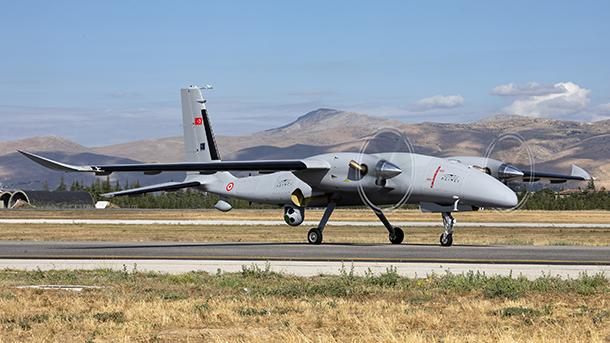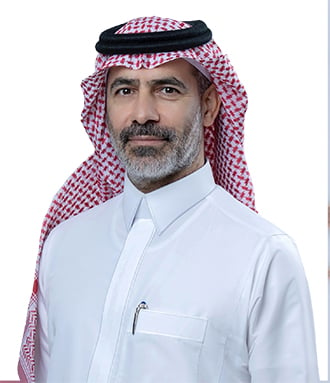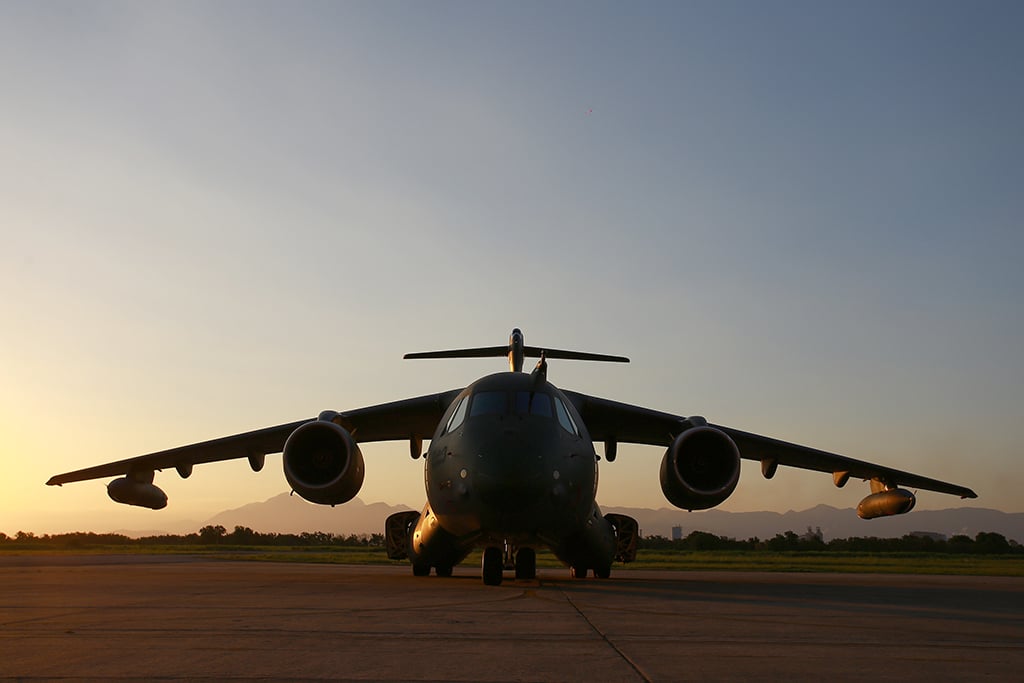
A SAMI business unit will be heavily involved in the production and assembly of Saudi Arabia’s new fleet of Baykar Akinci drones through a strategic cooperation agreement between Riyadh and Ankara signed in August 2022.
Aerospace is becoming a key pillar for Saudi Arabian Military Industries, as Riyadh aims to make half of defense acquisitions in-country by 2030.
The company, formed in May 2017 and owned by the nation’s Public Investment Fund (PIF), has had to develop quickly, not only to establish joint ventures and strategic agreements with some of the defense industry’s biggest names, but also to build development and production capacity to meet the needs of one of the world’s largest defense spenders.
- Saudi industry will produce Baykar’s Akinci UAS in-country
- Embraer and SAMI are exploring localization of C-390 maintenance and assembly
- SAMI is hopeful of a role on the Global Combat Air Program
- Saudi ministries now must produce procurement plans to boost transparency
Known generally by the acronym SAMI, the company is also taking on a role in producing the talent that would prop up the country’s growing defense industry and stimulate a domestic supply chain of privately owned small and midsize enterprises.

“Everyone knew from the very beginning, when Vision 2030 was launched, that the mandate of localizing 50% of the defense spend was an ambitious target,” SAMI CEO Walid Abukhaled told Aviation Week at the Dubai Airshow in November.
The former CEO of Northrop Grumman’s Middle Eastern business and a former Saudi deputy minister for industrial affairs, Abukhaled noted that 15% localization has already been achieved and said this process will accelerate as facilities and production get up and running.
These efforts have significant backing from the country’s armed forces, the General Authority for Military Industries (GAMI), the newly established General Authority for Defense Development (GADD) as well as the government in general, giving Abukhaled confidence that the 50% target can be achieved by 2030.
The CEO said that 40-50% of the 10 billion Saudi riyal ($2.7 billion) backlog in contracts signed since the company’s inception is related to the air domain, and is particularly focused on maintenance, repair and overhaul (MRO) and development and production of uncrewed aircraft systems (UAS).
SAMI is at the heart of a deal with Turkey’s Baykar that would see the company’s Akinci twin-turboprop medium-altitude, long-endurance UAS produced in Saudi Arabia for its own armed forces. “We will build the [Akinci] airframe, produce the avionics, cabling and harnesses, manufacturing this aircraft in Saudi Arabia,” Abukhaled explained (AW&ST Aug. 14-Sept. 3, p. 28). UAVs, he added, are a “strategic element” in SAMI’s aerospace business, which also foresees the domestic development of UAS products based on Saudi intellectual property.
During the Dubai Airshow, the company announced a new MRO business, SAMI Aerospace Mechanics, from SAMI’s 2019 takeover of the Aircraft Accessories & Components Co.
The company is already doing component MRO for the Royal Saudi Air Force’s (RSAF) fighter fleet, including the Eurofighter Typhoon and Boeing F-15, but will also have the capacity to offer services to commercial aircraft—though that is less of a priority for SAMI. “It makes sense that when you have invested in the capability you might as well use it to support the commercial market as well,” Abukhaled said.
But SAMI envisages supporting the commercial aerospace industry in other ways. It has a joint venture with France’s Figeac Aero to produce machined metallic components, while Riyadh-based SAMI Composites plans to do as its name suggests and build fuselage and wing parts, skin panels and movable surfaces.
SAMI has also taken over Alsalam Aerospace Industries, which is leading the conversion of the RSAF’s F-15S Eagle combat aircraft to the F-15SR standard, upgrading these older versions of the Eagle to the same standard as the RSAF’s new F-15SAs. Just as with the F-15SA program, any fighter acquisition by Riyadh in the future will require OEMs to have a “clear localization plan . . . [with] SAMI at the center of that,” Abukhaled said.
“Gone are the old days when a contract is signed and they deliver a state-of-the-art platform from the mother country,” he said. “With Vision 2030, no contract will be signed without clear local content and the ability to insert capability in the Kingdom.” Every OEM, Abukhaled insisted, now recognizes that things are different. “In order to be successful, you need to have a different strategy here,” he said.

Embraer’s target of getting its C-390 into the Saudi inventory, for example, led to the signing of a memorandum of understanding with SAMI about establishing a “comprehensive maintenance capability for the Embraer aircraft in the Kingdom,” the two companies announced on Nov. 29. As part of that effort, SAMI and Embraer aim to establish a comprehensive maintenance capability for the C-390. The companies are also exploring the creation of a regional MRO hub and even a final assembly line for the C-390, as well as a mission system integration facility in-country.
Abukhaled also hopes SAMI could play a role in the Global Combat Air Program (GCAP), the trination development of a sixth-generation combat aircraft by Italy, Japan and the UK. The British government and industry have briefed senior Saudi defense officials on the initiative, and the two countries have launched a joint feasibility study exploring the nations’ combat air relationship (AW&ST Oct. 2-15, p. 34).
“It is obviously up to the Saudi Ministry of Defense whether to enter the [GCAP] program,” Abukhaled said. “Here at SAMI, we are ready. We believe we can add lots of value to this program, and I have at least 500 software engineers who could be a part of this. . . . We have been investing heavily in developing our own capabilities; we could support GCAP, without hesitation.”
The ability to invest heavily has also been driven in recent months by increased transparency from the Saudi government. Riyadh now calls on every department, including the defense ministry, to prepare five- and 10-year plans. The 10-year plan must lay out a long-term financial commitment, while the five-year plan should detail requirements and capabilities. That process appears to align with deep reforms already underway in the armed services (AW&ST March 21-April 3, 2022, p. 42).
“I always say ‘What does my customer want?’ and that is what I have to invest in,” Abukhaled said. “Now they have these five- and 10-year plans, it gives me the opportunity to invest in the right things that my customer wants. It makes a huge difference to us in ensuring we put our investment in the right place.”
While other Gulf Cooperation Council countries seeking increased domestic defense capability have decided to invest globally to achieve that—the United Arab Emirates’ Edge Group being one example—SAMI is firmly set on meeting domestic requirements. “The focus will always be on satisfying the Saudi market. . . . The Kingdom is different because it has one of the largest defense budgets in the world, so it makes more sense to invest in efforts here.” International investments are not being discounted, nor are exports. A combat management system developed for naval vessels by SAMI Navantia is being requested for installation on the ships of allied nations, Abukhaled said.
Like the defense industry elsewhere, SAMI and the Saudi defense industry in general have struggled to find new engineering talent, which Abukhaled described as a “global challenge.” But the Saudi government hopes to address the issue with the creation of a new National Academy for Military Industries. Established by GAMI and located near Riyadh at Dirab, the academy is set to onboard its first students in January. Abukhaled is chairing the academy. “The aim is to get highly qualified Saudi technicians, avionics experts, mechanics, electricians, who can work on complex systems,” he said.
There is also a desire to create an ecosystem of defense suppliers and small and midsize enterprises that can feed the growing Saudi defense industry. “We need a solid supply chain in Saudi Arabia, that means Tier 2 and 3 suppliers,” Abukhaled said. “We are committed to building the Saudi supply chain, because SAMI can never be successful alone.”
He said plans are in motion to establish a new program in conjunction with GAMI and the defense ministry to study the country’s established industrial capabilities and potentially invest in them in conjunction with strategic partners, to qualify them as suppliers. “If it requires an investment from our side, we’re absolutely open to it, to ensure that they can deliver the product to us to international standards and the right quality,” Abukhaled said.
Looking to the future, Abukhaled noted that SAMI on its own would not be able to deliver everything demanded of it by the Saudi customer, but is willing to work with strategic partners to meet the country’s needs. “We have a clear road map on how to get there by 2030,” he said. He noted that the extensive reforms put in place by Crown Prince Mohammed bin Salman have begun to transform the Saudi economy, resulting in increased foreign investment, trade and tourism. “I don’t see it as a Vision 2030, I see it as a reality,” Abukhaled said.





